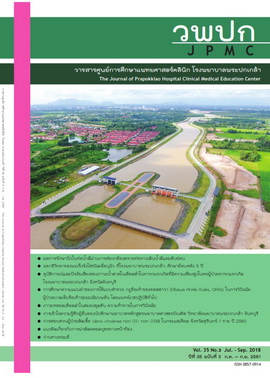Cerebral Venous Sinus Thrombosis: A Diagnostic Challenge
Main Article Content
Abstract
Abstract
Background: Cerebral venous sinus thrombosis (CVST) is an unusual cause of stroke, which accounts for less than 1% of all cases of stroke. The diagnosis is generally delayed due to a wide spectrum of clinical symptoms. Delay in the diagnosis and treatment of CVST usually results in death.
Objective: To identify the factors that may predict a delay in the diagnosis, morbidity and mortality outcomes in patients with CVST.
Materials and methods: A retrospective review of all cases of CVST diagnosed at the Prapokklao Hospital, Chanthaburi Province, Thailand between January 2013 and December 2017.
Result: Thirty-nine cases of CVST were identified. There were 24 (61.5%) female and 15 (38.5%) male patients with a median age of 37 years. The duration of the time that the patients were presented to the hospital until CVST was diagnosed was less than 24 hours for 12 cases, 24-48 hours for 13 cases, and more than 48 hours for 14 cases. The correct diagnosis rate at admission was only 23%. The only one factor that predicted a delay in the diagnosis was a Glasgow coma score, which was less than 12 at admission. The most common risk factor in female patients was oral contraceptive pill consumption. For most of the male patients, the risk factors could not be identified (8/15 cases). The morbidity rate was 20.5% and mortality rate was 10.3%, which showed no difference between the three groups.
Conclusion: The diagnosis of CVST should be considered in women with headache and any other neurological symptoms, especially for those females who have taken oral contraceptive pills and had unexplained intracerebral hemorrhage.
Key words: cerebral venous sinus thrombosis; headache; oral contraceptive pill
Article Details
References
2. Stam J. Thrombosis of the cerebral veins and sinuses. N Engl J Med 2005;352:1791-8
3. Ferro JM, Canhao P, Bousser MG, Stam J, Barinagarrementeria F. Cerebral vein and dural sinus thrombosis in elderly patients. Stroke 2005;36:1927-32
4. Bushnell C, Saposnik G. Evaluation and management of cerebral venous thrombosis. Continuum (Minneap Minn) 2014;20:335-1.
5. Pfefferkorn T, Crassard I, Linn J, Dichgans M, Boukobza M, Bousser MG. Clinical features, course and outcome in deep cerebral venous system thrombosis: an analysis of 32 cases. J Neurol 2009; 256:1839-45
6. Ferro JM, Canhão P, Stam J, Bousser MG, Barinagarrementeria F, Massaro A, et al. Delay in the diagnosis of cerebral vein and dural sinus thrombosis influence on outcome. Stroke 2009;40: 3133-8.
7. Gameiro J, Ferro JM, Canhão P, Stam J, Barinagarrementeria F, Lindgren A. Prognosis of cerebral vein thrombosis presenting as isolated headache: early vs. late diagnosis. Cephalalgia 2012;32: 407-12.
8. Fink JN, Mcauley DL. Cerebral venous sinus thrombosis: a diagnostic challenge. Intern Med J 2001; 31:384-90.
9. Pfefferkorn T, Crassard I, Linn J, Dichgans M, Boukobza M, Bousser MG. Clinical features, course and outcome in deep cerebral venous system thrombosis: an analysis of 32 cases. J Neurol 2009;256:1839-45
10. Honig A, Eliahou R, Eichel R, Shemesh AA, Ben-Hur T, Auriel E. Acute bilateral infarct manifesting as sleep-like coma: a diagnostic challenge. J Clin Neurosci 2016;34:81-5.
11. Martinelli I, Sacchi E. Landi G, Taioli E, Duca F, Mannucci PM. High risk of cerebral vein thrombosis in carriers of prothrombin gene mutation and in users of oral contraceptives. N Engl J Med 1998;338:1793-7.
12. Korathanakhun P, Sathirapanya P, Geater SL, Petpichetchian W. Predictors of hospital outcome in patients with cerebral venous thrombosis. J Stroke Cerebrovasc Dis 2014;23:2725-9.
13. Knudsen-Baas KM, Krakenes J, Thordarson HB, Sjo M, Waje – Andressen U. Cerebral venous thrombosis and hyperthyroidism. Intern Med [Internet]. 2014 [cited 2018 Mar 22];4:1-5.
Available from: https://www.omicsonline.org/open-access/cerebral-venous-thrombosis-and-hyperthyroidism-2165-8048.1000136.pdf
14. Saadatnia M, Fatehi F, Basiri K, Mousavi SA, Mehr GK. Cerebral venous sinus thrombosis risk factor. Int J Stroke 2009;4:111-3.
15. Franchini M, Lippi G, Targher G. Hyperthyroidism and venous thrombosis: a casual or causal association? A systematic literature review. Clin Appl Thrombo Hemost 2011;17:387-92.
16. Canhão P, Ferro JM, Lindgren AG, Bousser MG, Stam J, Barinagarrementeria F. Causes and predictors of death in cerebral venous thrombosis. Stroke 2005;36:1720-5.
17. de Bruijn SF, de Haan RJ, Stam J. Clinical features and prognostic factors of cerebral venous sinus thrombosis in a prospective series of 59 patients. J Neurol Neurosurg Psychiatry 2001; 70:105-8.
18. Girot M, Ferro JM, Canhão P, Stam J, Bousser MG, Barinagarrementeria F, et al. Predictors of outcome in patients with cerebral venous thrombosis and intracerebral hemorrhage. Stroke 2007;38:337-42.
